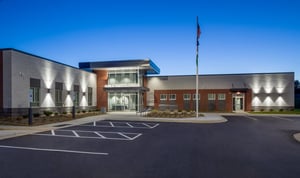The Aging PSAP: Is it Time for a New Facility?
Posted on November 19, 2019 by Pat McFeely
 Public safety answering points (PSAPs) and emergency operations centers (EOCs) must provide security and peace of mind for communities and first responders. Unfortunately, many agencies are faced with aging facilities and technologies that no longer meet their needs or the needs of those they serve.
Public safety answering points (PSAPs) and emergency operations centers (EOCs) must provide security and peace of mind for communities and first responders. Unfortunately, many agencies are faced with aging facilities and technologies that no longer meet their needs or the needs of those they serve.
The decision to take on a new facility project is no small undertaking and, with limited budgets and resources available, is not a decision to be made lightly. How do agencies and public safety leaders evaluate existing facilities and make the case for a facility upgrade?
Identify Stakeholders’ Needs
Each stakeholder group has specific needs to be met by any mission-critical facility:
- Communities need to know that they’ll be able to reach emergency services in their greatest time of need, and that the building (or buildings) housing those services is able to withstand most disasters, both natural and manmade.
- First responders need to be able to depend on PSAPs, EOCs and their technologies to stay connected to dispatchers and respond to emergencies quickly and efficiently.
- Public safety agencies and their employees need to be in a safe, comfortable environment with current technologies to assist first responders in a seamless response to emergencies.
- Government officials and other decision-makers need to know that a new facility will be achievable within specific budget parameters and a reasonable timeframe, and that funding sources will be available to support the project.
Conduct a Facility Assessment
Once you understand what each stakeholder needs, you can assess your current facility. Asking these questions is a great starting point:
- Is the building old, small or in need of significant repairs?
- Has it been hardened to secure the facility and support continued operations in the event of a disaster?
- Does the building pose health, safety or other risks to its occupants?
- Can the space accommodate the staff needed to handle the current response requirements?
- Are the components, systems and networks housed within the facility up to date, protected and redundant to ensure continued operations?
- Do the facility and the building meet or exceed current industry and building standards?
- Will it cost more over time to continue maintaining the current facility through repairs and upgrades compared with the costs associated with building new?
Assessing your current facility in alignment with your stakeholders’ needs will help you identify where improvements to your existing facility can be made and what they will cost. Or, the evidence may indicate it makes more sense to begin the process of securing funding to build a new facility.
Iredell County, N.C.: A Case Study in Facility Assessment and Improvement
In Iredell County, N.C., small, disparate facilities and aging technology were negatively impacting emergency response and increasingly limiting the ability to meet the community’s needs. Meanwhile, public safety employees were faced with less-than-ideal working conditions that had begun to impact their overall health and the ability to recruit and accommodate enough employees to handle the County’s response to emergency requests for service. Further, the physical separation between the facilities made collaboration and resource sharing difficult, if not impossible.
The County assessed its current facilities, staff working conditions and technologies. It identified the need for a new, larger emergency communications facility that could accommodate more telecommunicators and implemented state-of-the-art technologies to improve emergency response. In addition, the County placed employee wellness at the forefront of the project and identified specific changes that could be made to the working environment to improve staff morale and departmental collaboration, as well as recruitment and retention.
MCP supported the County through the design, programming and implementation of the new emergency communications facility and its technologies and systems, which opened in January 2019. Read more about it here.
Topics: Mission-Critical Facilities, Consulting


